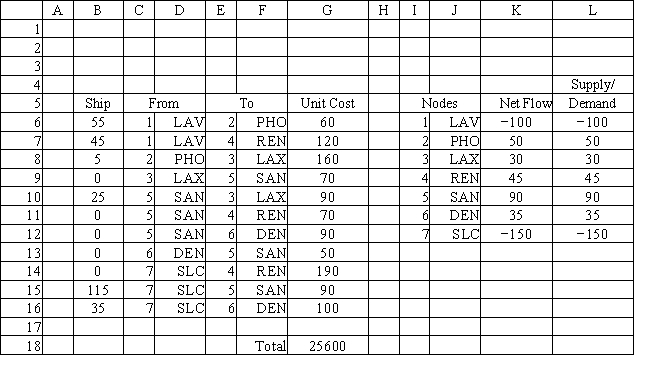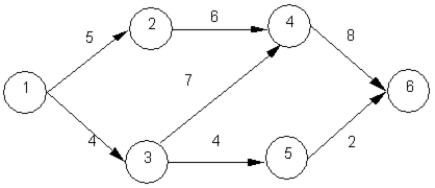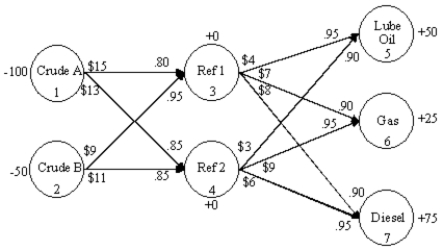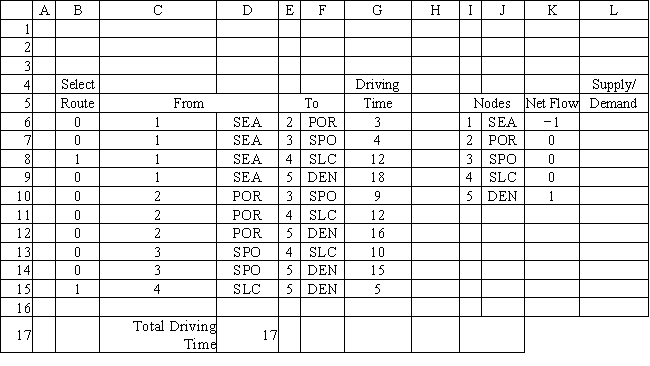A) Modify the cost on arc 4-5 to account for only operating costs.
B) Add a second arc 4-5 to represent just the operating costs.
C) Add a dummy node, 6, so that arc 4-6 represents just the operating costs.
D) Add a dummy node, 6, so that arc 4-5 represents operating costs and 5-6 represents new equipment purchase.
Correct Answer

verified
Correct Answer
verified
Multiple Choice
Demand quantities for demand nodes in a transshipment problem are customarily indicated by
A) positive numbers.
B) negative numbers.
C) imaginary numbers.
D) either positive or negative numbers.
Correct Answer

verified
Correct Answer
verified
Multiple Choice
The equipment replacement problem is an example of which network problem?
A) transportation problem.
B) shortest path problem.
C) maximal flow problem.
D) minimal spanning tree problem.
Correct Answer

verified
Correct Answer
verified
Essay
A company wants to determine the optimal replacement policy for its delivery truck. New trucks cost $30,000. The company does not keep trucks longer than 2 years and has estimated the annual operating costs and trade-in values for trucks during each of the 2 years as: 
Draw the network representation of this problem.
Draw the network representation of this problem.
Correct Answer

verified
Correct Answer
verified
Multiple Choice
Which method is preferred for solving fully connected transportation problems?
A) linear programming
B) network flow methods
C) trial and error
D) simulation
Correct Answer

verified
Correct Answer
verified
Multiple Choice
Which formula should be used to determine the Net Flow values in cell K6 in the following spreadsheet model? 
A) SUMIF($C$6:$C$16,I6,$B$6:$B$16) −SUMIF($E$6:$E$16,I6,$B$6:$B$16)
B) SUMIF($I$6:$I$12,B6,$B$6:$B$16) −SUMIF($I$6:$I$12,I6,$B$6:$B$16)
C) SUMIF($E$6:$E$16,I6,$B$6:$B$16) −SUMIF($C$6:$C$16,I6,$B$6:$B$16)
D) SUMPRODUCT(B6:B16,G6:G16)
Correct Answer

verified
Correct Answer
verified
Multiple Choice
What happens to the solution of a network flow model if side constraints are added that do not obey the balance of flow rules?
A) The model solution is not guaranteed to be integer.
B) The model solution will more accurately reflect reality.
C) The model solution will be integer but more accurate.
D) The model solution is not guaranteed to be feasible.
Correct Answer

verified
Correct Answer
verified
Multiple Choice
What is the correct constraint for node 2 in the following diagram? 
A) X12 + X23 = 100
B) X12 − X23 ≤ 100
C) −X12 + X23 ≥ −100
D) X12 − X23 ≥ 100
Correct Answer

verified
Correct Answer
verified
Essay
Solve the following minimal spanning tree problem starting at node 1.

Correct Answer

verified
Correct Answer
verified
Multiple Choice
How could a network be modified if demand exceeds supply?
A) add extra supply arcs
B) remove the extra demand arcs
C) add a dummy supply
D) add a dummy demand
Correct Answer

verified
Correct Answer
verified
Multiple Choice
Maximal flow problems are converted to transshipment problems by
A) connecting the supply and demand nodes with a return arc
B) adding extra supply nodes
C) adding supply limits on the supply nodes
D) requiring integer solutions
Correct Answer

verified
Correct Answer
verified
Multiple Choice
A factory which ships items through the network would be represented by which type of node?
A) demand
B) supply
C) random
D) decision
Correct Answer

verified
Correct Answer
verified
Multiple Choice
An oil company wants to create lube oil, gasoline and diesel fuel at two refineries. There are two sources of crude oil. Consider arc 2-4. The per unit shipping cost of crude B from source 2 (node 2) to refinery 2 (node 4) is $11 and the yield is 85 percent. The following network representation depicts this problem. What is the balance of flow constraint for node 3 (Refinery 1) ? 
A) X13 + X23 − .95 X35 − .90 X36 − .90 X37 = 0
B) .80 X13 + .95 X23 − X35 − X36 − X37 = 0
C) .80 X13 + .95 X23 − .90 X36 − .90 X37 ≥ 0
D) X13 + X23 − X35 − X36 − X37 ≥ 0
Correct Answer

verified
Correct Answer
verified
Multiple Choice
The assignment problem is equivalent to a transportation problem with
A) the sums of all rows and columns equal to one.
B) binary decision variables.
C) non-negativity constraints removed.
D) all of the above.
Correct Answer

verified
Correct Answer
verified
Multiple Choice
Which balance of flow rule should be applied at each node in a network flow problem when Total Supply > Total Demand?
A) Inflow − Outflow ≤ Supply or Demand
B) Inflow − Outflow ≥ Supply or Demand
C) Inflow − Outflow = Supply or Demand
D) Inflow − Supply ≥ Outflow or Demand
Correct Answer

verified
Correct Answer
verified
True/False
The equipment replacement problem is a common type of business problem that can be modeled as a shortest path problem.
Correct Answer

verified
Correct Answer
verified
Multiple Choice
Decision variables in network flow problems are represented by
A) nodes.
B) arcs.
C) demands.
D) supplies.
Correct Answer

verified
Correct Answer
verified
Multiple Choice
Consider modeling a warehouse with three in-flow arcs and three outflow arcs. The warehouse node is a transshipment node but has a capacity of 100. How would one modify the network model to avoid adding a side constraint that limits either the sum of in-flows or the sum of the out-flows to 100?
A) Place a limit of 34 on each in-flow arc.
B) Add a side constraint limiting the out-flow arcs sum to 100.
C) Separate the warehouse node into two nodes, connected by a single arc, with capacity of 100.
D) It cannot be accomplished, a side constraint must be added.
Correct Answer

verified
Correct Answer
verified
Essay
A trucking company wants to find the quickest route from Seattle to Denver. What values should be placed in cells L6:L10 of the following Excel spreadsheet? 
Correct Answer

verified
Correct Answer
verified
Multiple Choice
The demand nodes in the graphical representation of the transshipment problem:
A) have total demanded quantities expressed as positive numbers
B) have all directed arcs originating at them
C) have some unidirectional arcs
D) have total available quantities expressed as negative numbers
Correct Answer

verified
Correct Answer
verified
Showing 41 - 60 of 92
Related Exams